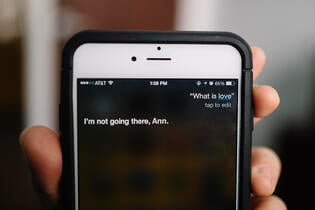Blog
Make a Learning Love Connection: Five FACTS for Better e-Learning Courses
by Ann Iverson, instructional designer | @iverson_ann Everyone wants to laugh. Our inherent desire for humor leads us to share YouTube videos of ...


Make 'Em Laugh: 4 Ways to Create e-Learning Courses with Humor
By Ann Iverson | September 09, 2014 | Custom Learning | 0 Comments
Everyone wants to laugh. Our inherent desire for humor leads us to share YouTube videos of laughing babies and frowning cats, and use acronyms like LOL in our text messages. But humor does not belong in serious e-learning courses, right? Well, think again. Making people laugh has been scientifically proven to relieve stress, improve productivity and motivate employees. Humor can even increase learner retention of concepts and situations that might otherwise be easily forgotten.
I know what you’re thinking. Whenever you try to bring up the humor card, your SMEs respond with, “This is serious business we’re dealing with here. It’s no laughing matter.” So even though you know that courses with even just a bit of humor are usually the most memorable, you may have to convince your stakeholders.
Start by asking, “What’s the tone of this course?” You’ll get a sense if it’s professional, casual, evaluative or humorous – categories identified by Ethan Edwards in the Practitioner’s Guide for CCAF Context Design Road Map for e-Learning. If you get the sense that stakeholders are open to humor, follow up with a specific idea like, “What if our theme was based on The Office?” or “Have you seen the latest commercials about the website that helps you find cheap hotel rooms?” If at first the group seems closed off, you may want to push the envelope a bit. Try asking, “What shows or ads do you remember over time? The funny ones, or the boring ones?” Hopefully, they’ll get the point. But if not, don’t give up! Injecting even a touch of humor can help engage learners.
Take a look at this example of adding humor to a topic you may not usually think of as funny – safety training.
In courses about safety and compliance, for example, humor can help motivate learners to want more. What a great surprise to be welcomed by a lighthearted coach who provides personal anecdotes that reveal his vulnerabilities, like walking into a wall on the way to work that morning.
Writing with humor in course scripts and storyboards can inspire the entire development team. Media artists join in the fun and create imagery that supports the theme. In a course about conflict resolution, one of our media gurus here at Allen Interactions, Christopher Palm, created Conflicto, a purple monster that scales the walls of an office building when things get out of hand. Learners have to choose the best way to manage the turmoil so the monster retreats from its threatening position. Will learners remember fighting off Conflicto with the right choices more than clicking steps in a process, for example, to learn how to manage conflict at their workplace? Most likely!

Here are four ways you can increase the chuckle factor in your e-learning courses:
Use Real, but Unexpected Language
Most business situations are not inherently funny, but adding an unexpected element can make learners laugh and help them remember the important concepts. A scenario about a salesperson working with a challenging client becomes humorous when it includes unexpected statements like, “Who is the idiot in charge here?" A potential response might be, "I'm the head idiot. How can we solve this problem?” Of course, this type of exchange needs support and approval from your stakeholders and SMEs, but is more likely to grab the learner’s attention than this: Mr. Customer is unhappy with the results of the new product you recently sold him. What is the first step in overcoming his objections?
Make It Obvious
Find ways to let learners know that not only is it okay to laugh, but you want them to. For example, create a character that’s goofy and makes impossible mistakes, but provides a platform for ‘what not to do.’ Or create an amusing context. One of funniest courses I’ve seen has a comic strip theme with a superhero that leaps tall buildings to help employees give effective feedback. Just remember to keep the message front and center without making the humor the main subject of the course.
Add the Details
Specificity is funnier than generalizations. For example, all new employees experience a bit of anxiety on their first day of the job. But imagine a new employee who shows up with fresh coffee stains on her blouse, a smart phone ringing to the tune of “Born to be Wild” and who can’t remember her new manager’s name. How do you greet her and make her feel most welcome?
Ask for Help
Be sure your use of humor doesn’t sidetrack the true purpose of your course. If you’re hesitant, ask a colleague to read your script and then give you a candid critique with this in mind. Yes, the truth can hurt, but better it come from one trusted peer than a large review audience.
While humor comes more easily to some than others, anyone can use the above four tips to add some hilarity to e-learning courses. Because after all, humor engages and holds interest. It creates a kind of playfulness that helps learners feel connected. So use humor when you can to make ‘em laugh. Chances are your courses will be more memorable, meaningful and motivational!
Want to share this post? Here are some ready made tweets!
Click to Tweet: Make 'Em Laugh: 4 Ways to Create e-Learning Courses with Humor http://hubs.ly/y07yX10 by @iverson_ann #elearningdesign #elearningblog
Click to Tweet: Learn the 4 ways to increase the chuckle factor in your e-learning courses! http://hubs.ly/y07yX10 #makeemlaugh by @iverson_ann #elearning
Click to Tweet: Humor can help motivate learners to want more! http://hubs.ly/y07yX10 by @iverson_ann #elearningdesign #laughandlearn
.png?width=135&height=135&name=Ann(250).png)
About the Author: Ann Iverson
Ann is an instructional designer for Allen Interactions who’s consulted for many years with a variety of clients, industries and projects. She learns best by making mistakes!
Comments
Would you like to leave a comment?
Related Blog Posts

By: Ann Iverson | Feb, 2015
Category: Custom Learning
.jpg.jpg?width=316&name=4Questions(Title).jpg.jpg)
Blog
Four Questions that Shift You into Design Success
by Ann Iverson, instructional designer | @iverson_ann Everyone wants to laugh. Our inherent desire for humor leads us to share YouTube videos of ...
By: Ann Iverson | Dec, 2014
Category: Custom Learning, Strategic Consulting

Blog
Be an Advocate for Dumping the Information Dump
by Ann Iverson, instructional designer | @iverson_ann Everyone wants to laugh. Our inherent desire for humor leads us to share YouTube videos of ...
By: Ann Iverson | Jul, 2014
Category: Custom Learning

.png?width=120&height=120&name=ann(250).png)

